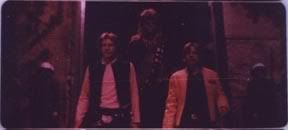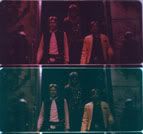Originally posted by: zombie84
Okay to end all the debate about what prints exist and what went on with the SE:
-Because the original 1976/1977 negatives were beginning to deteriorate, a fairly exhaustive restoration was needed to save them. The problem with Kodak Eastman 35mm negative stock is that it does not live long--the colours and tones are never as vibrant or true as what is actually photographed, and whats worse the stock fades away and deteriorates over time...much more rapidly than people first realised. In fact certain shots had faded so much that they had "gone pink"--i believe the technical terminalogy for this may be a yellow layer failure, although i am not certain. In order to get the shades correctly certain pieces had to be duplicated and then re-timed to eliminate the pink tint. The corrected pieces were then re-inserted into the O-neg reel, replacing the deteriorated originals. Other shots had gone so bad that they couldn't be re-timed and instead had to be replaced with frames from an Interpositive print. The footage was all cleaned and washed by hand--in fact many of the tatooine shots had sand built into the film!
-Once the final reel had been restored SFX shots were re-composited into the computer. To do this they scanned the original elements--the raw bluescreen model shots and the on-set plates, both of which were kept in Lucasfilm's extensive archive, at 2K resolution (the maximum technology allowed at the time). Compositing digitally eliminates matte lines and dupe grain from the optical composite process. Transition shots--wipes, dissolves--were also redone digitially. The crawl was redone digitally as well, as far as i know. After all these changes were done they were printed back onto 35mm negative film and re-spliced into the O-neg reel, replacing the original pieces
-then there were shots that were enhanced with CG. To do this the original negatives were scanned at 2K res and then ILM did their thing. The final CGI-enhanced shots were then printed back out onto 35mm negative film and the pieces re-spliced into the O-neg reel, replacing the original shots
-then there were the totally new shots. Some of these involved filming new elements (ie more extras, sandtroopers, new model shot of sandcrawler) in which case the film was probably scanned for some touch-ups but most were created digitally. The finished shots were then printed back onto 35mm negative film and inserted into the O-neg reel
-finally, since the O-neg shots are litterally the raw footage filmed from the camera, they need to be colour timed. In order to faithfully re-produce the original colours, George Lucas gave YCM Labs, the lab that did the restoration, a perfect technicolor print of the 1977 original. Unlike Eastman Kodak, Technicolor does not fade away over time, and not only that it has superior tone and colour information as well as much less grain. It also came to light that Lucas had technicolour seperation masters made for him in 1977 as well.
-Finally, the colour-timed O-neg reel was printed into a new Interpositive. Hence the 1997 SE is born.
You can see what happened here--little by little, the original film was consumed by new pieces. This is what Lucas meant when he said "its impossible to make a new OOT, the negative doesn't exist." Well, technically, it doesn't. You may also be wondering what happened to the original pieces that were replaced: well, me too. Undoubtedly, they were put back into storage, although the pieces that had deteriorated to garbage may have indeed been destroyed.
But we're not done here. Because an equally important process occured, probably in early 2004 for the S-SE (or whatever you want to call it).
So now we have the new O-neg configuration. But Lucas wants to change it again.
-So, the O-neg is scanned--but in HD resolution. And the O-neg of course is now the 1997 SE
-Because the O-neg is scanned and not the re-timed 1997 IP that means that all the colour-timing information is lost. So the film must be re-timed, now in a DI environment. Because Lucas is linking the films up to the prequels a very different look is decided upon--very constrasty and "modern", which particularly is different for ANH and ROTJ which were very softly lit originally. Apparently Lucas approved the final colur-timings personally
-from here the O-neg is altered in the digital environment once again, but unlike the 1997 version now the entire thing is digitized. The additions are made: gungans, ESB McDiarmid, Hayden, etc.
-then Lowry gets a hold of it. My understanding is that they were the last of the line but it seems to me that a more logical workflow would be to have ILM work from the cleaned-up Lowry files. But as far as i remember, ILM did their alterations before. Then the HD files are given over to Lowry. Lowry uses its clean-up algorithim to remove thousands of bits of dirt and grain through computer-controlled software. Some sharpening filters were also used to bring out detail in certain areas deemed soft.
-From here an digital HD master is finally produced of the final product. Thus is borne the 2004 S-SE. The films are now existing purely as data, and from this data the DVD down-conversions are made.
I am going to point out the obvious here--the 2004 S-SE is only HD res. Apparently Lucas must think this is okay since thats what he filmed his prequels in but for anyone who loves the SE this is a major bummer.
I hope this clears up any confusion regarding the SE. This info comes courtesy of many articles and interviews from various sources. Go Mer I can't believe you are still asking about this--i know for sure i have explained this in the lengthy TFN thread at least ten times.
As for Lucas, yes, he did actually say that the original negative was destroyed--this is a twisted exageration based on the fact that the 1977 O-neg technically has been annhilated, but not in the sense that it has been chucked into a furnace, which is what he is trying to get people to think. It could easily be re-constructed, or, even cheaper and downright better IMO, simply use the Technicolour seperation masters to make a new DI--a perfect copy of a pefect IP. Nor would any of this be expensive, relatively speaking, and a DI of the seperation masters would probably run about $100,000 or so, which is absolutely peanuts for LFL.





